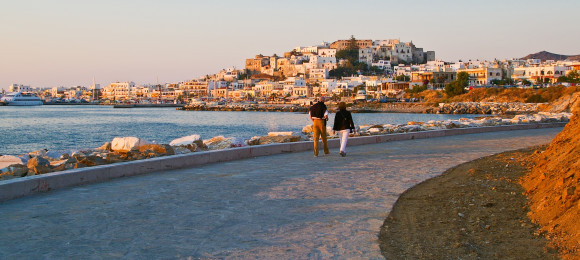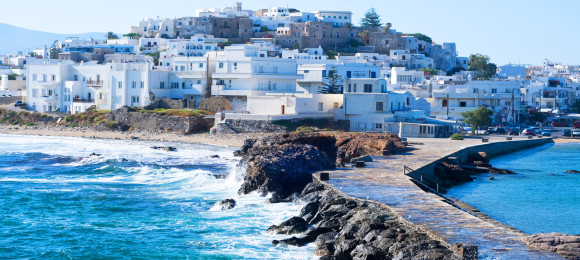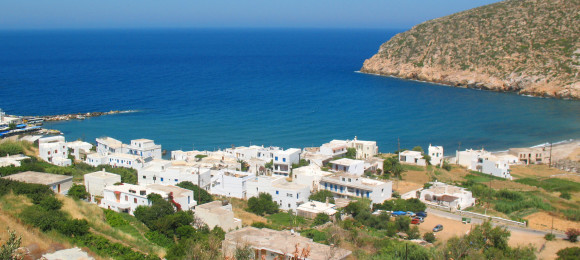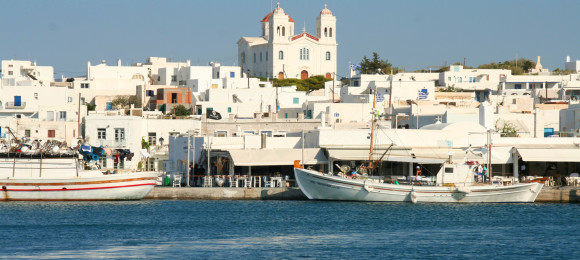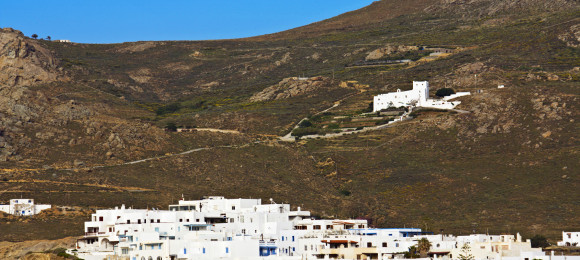Overview of Naxos
Atmospheric and peaceful, varied and low profile, Naxos is full of surprises. The largest of the Cyclades -and also the greenest one- has become increasingly popular among the Greek islands. Its landscape alternates between mountainous terrain (including Mt Zas, the highest in Cyclades), barren regions, fertile valleys, springs and a 90 km almost straight coastline with endless, beautiful sandy beaches -something rarely met in Cyclades.
Picturesque villages, forts and churches “interfere” harmoniously in this scenery, together with fascinating sights of classical Greek, byzantine and Venetian origin. In Naxos, tourism has developed in moderation, allowing tradition to evolve at its own pace. An example of that can be seen in the island’s port and capital of Chora: Touristic facilities, nightlife options, shops and restaurants (many of which found in Platia Evripeous) co-exist with the ancient, much photographed Portara and the impressive Kastro (Castle), prime heritage of the Venetian Duchy of the Aegean/Archipelago that was founded here in 1207 by Marco Sanudo.
Another must-see is Naxos’ traditional mountain and coastal villages, each one its own peculiarity and beauty. Most of them feature a splendid mixture of Venetian towers, Cycladic windmills, Byzantine churches, stone houses, narrow alleys, etc. The most famous is Apiranthos, a picturesque mountain settlement known as “the marble village”, whose inhabitants use a special dialect due to their Cretan roots. On the other hand, lively and touristic developed Filoti is the island’s biggest village, set amphitheatrically in a valley near Mt Zas. This diversity is the true charm of Naxos, a destination where you can magically combine vacations in both island and mountain.
Find more information on Naxos at the official website for Greek Tourism VisitGreece.gr
Beaches
Food
Things to see & do
: Rightfully among the best beaches of all Greek islands, it is a long seashore with fine sand, organized in most of its parts, offering a variety of amenities. It is also very popular. 10.0 : Endless golden sandy beach with turquoise waters and dunes. In parts it could be crowded, organized or isolated (nudists prefer the latter). 9.0 : Sandy and family friendly, it’s next to Naxos’ Chora and offers all kinds of facilities. 8.0 : Partly organized beach with white sand, crystal waters and cedar trees. Facilities are available in the village of the same name. 8.0 : It is actually two beaches split by a huge rock, ideal for windsurfing and kite surfing. 8.0 : Exotic looks, white sand and cedar trees all around create the best ambience to relax and enjoy swimming. 8.0
: Moutsouna, Mediterranean cuisine 9.0 : Chora, Italian cuisine 9.0 : Chora, Greek cuisine 8.0 : Chora, Greek cuisine 8.0 : Chora, Greek, Mediterranean and international cuisine, 8.0
: Wander around the castle of the dukes and explore its medieval settlement with mansions (still inhabited by descendants of the Venetians), museums, piazza and Roman Catholic Cathedral, among others. The mystifying feeling, mixed with the Cycladic architecture of Chora, is truly unforgettable. 10.0 : This is the alternative name of the archaic (6th century BC) temple of Apollo, located on islet Palatia that dominates the island’s entrance. It’s the island’s number one trademark, a work which was never completed. According to the myth, Naxos was the home of Dionysos, god of wine and pleasure, who built this temple for his beloved Ariadne. 10.0 : The famous gigantesque Greek statues, made of local marble, can be found in villages Melanes and Apollonas (the biggest one lays here and measures 10.45 m). While you’re there, stroll around Apollonas, a coastal picturesque village with a lovely beach. 9.0 : Nature lovers will be thrilled to discover the beauties of Naxos through its footpaths. One of the most popular routes for spectacular views is from outside village Filoti to Mount Za – on the way up, check out also the cave of Zas (alias Zeus). 8.0 : Enjoy some island hopping to the neighboring islands of Delos, Mykonos, Paros, Amorgos, as well as the Little Cyclades complex (Donousa, Schinousa, Iraklia and Koufonisia). 8.0 : Don’t miss the chance to visit the photogenic former capital of Naxos, with its neoclassical houses, the restored 17th c Grazia-Barozzi tower and the Valindra Kitron distillery. 8.0 : Built in 530 BC, it is a marble ionic temple dedicated to goddess Demeter. It is located at Sagri village, that’s worth a visit to admire its Venetian towers, traditional windmills and many Byzantine churches. 8.0 : One of the most important cultural events taking place in the Greek islands, it is mainly celebrated every summer in the exemplary restored Bazeos Tower, one of the nearly 30 towers of the island. 7.0 : Naxos is famous for its many delicious types of cheese, such as graviera, arseniko, xinomyzithra, etc, as well as its premium wine and kitron liqueur. 7.0
Reviews of Naxos
No text reviews of Naxos exist. You can be the first one to review Naxos.


